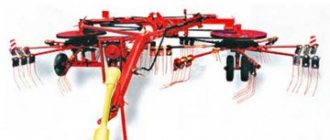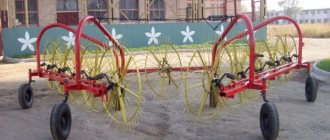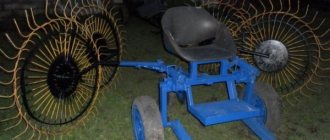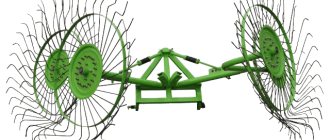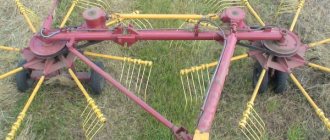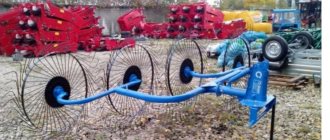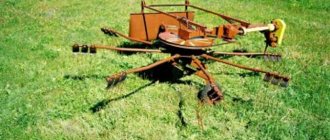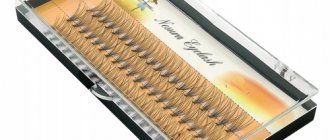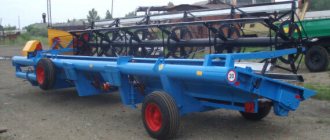Homemade tedder rake for tractor Special equipment
Tractor rake Kverneland Taarup 95150 C
Tractor rake is necessary for raking hay into windrows. When preparing feed for livestock, this equipment can provide invaluable assistance to the farmer.
It is worth noting that almost anyone can make a tractor hay rake with their own hands. Considering these features, every zealous owner should acquire such a unit.
In this article we will look at the design features, make a brief overview of the models and tell you how you can make a hay rake with your own hands.
Tedder rake: for tractor, hay, do it yourself
Since ancient times, rakes have become a handy tool for cleaning land areas and plots. This tool can be used to rake up hay, leaves, weeds and other debris while cleaning, for example, your yard.
Due to technological progress that also affected the agricultural industry, even the simplest tools have undergone technical perfection. They were replaced by tedder rakes (turners say otherwise), which are attached to a mini tractor.
1 Types of tedders
The most commonly used type is a hay rake. To harvest it, you need a tool that performs tasks such as raking grass, turning and collecting hay into windrows. These universal tools are turners, which are divided into groups:
- by the nature of manufacturing of the working part;
- by type of traction;
- according to the method of formation of wolves;
- by type of fastening.
By type, such devices for tractors can be divided into two parts:
Tedders Sunshine for a mini tractor
- wheel-mounted (for example, Solnyshko tedder rake);
- rotary.
Wheeled ones usually have 3-5 built-in wheels, located obliquely from each other. This increases overall labor productivity. Using the mounted rake of the tedder increases both the gripping area and the thoroughness of raking the grass, and, accordingly, the speed of work as a whole.
A simplified repair of the wheelbase is noted in Solnyshka - tractor tedders and rakes have interchangeable wheels secured by two bearings.
The most popular among Solnyshko tedders are the GVK tedder rakes, which allow you to rake windrows on both sides at once and turn hay.
Among the advantages of the Solnyshko tedders are:
- low level of labor costs for servicing the mechanism;
- mounted tedder rake ensures longer service life;
- have a powerful traction drawbar and frame (more relevant to factory production);
- convenient transfer of the unit to the working or transport position, which is implemented through the hydraulic system by the tractor operator;
- Convenience of adjusting the pressure of the drive wheels.
Tedders for walk-behind tractor
Rotary tedder rake includes horizontally located disks (rotors) that are connected to the engine and rotate under the influence of the PTO.
Metal pipes with fingers made of iron rods are attached to the rotors. Like tractor rakes, rotary tedders do their “duties” well, but they also have specialization.
How to make a rake for a tractor?
Making a rake for a tractor with your own hands is not that difficult. A homemade design will differ from the factory one in parameters that are ideally selected for your conditions of use. Before starting production, you should decide on the type of future equipment (wheeled or rotary rakes). First of all, the choice will depend on the type of terrain. Rotary rakes are suitable for flat terrain, as they work at a certain height. On hilly, uneven surfaces it will be easier to work with a wheeled adjustable rake.
You should also acquire drawings, tools and necessary supplies.
Drawing of a wheeled rake of the “Sun” type
To make a wheeled rake of the “Sun” type you will need:
- tools - welding, grinder, wrenches, drill, measuring tools, etc.;
- metal pipes for the frame (you can take a ready-made frame from an old motorcycle);
- wheel brackets;
- wire about 6 mm thick for making raking fingers;
- metal sheets about 4 mm thick for making working disks;
- wheel bearings;
- spare parts for the manufacture of a device for attaching to a tractor.
The hubs from the car are suitable for mounting the wheels.
Then it’s just a matter of small things – fastening all the parts together and connecting the equipment to the tractor. The video below demonstrates the working capabilities of homemade rakes of this type on a KhTZ tractor: To make a rotary rake for a tractor, you will need the following materials:
- metal rods with a diameter of about 1 cm;
- pipes with an outer and inner diameter of 5 cm;
- metal profile for frame;
- cardan shaft;
- a set of gears and chains;
- sheet of metal about 5 mm thick (to strengthen the structure).
The manufacturing process begins with the assembly of the frame. The width will depend on the attachment to the tractor, the length - on the working grip of the rake. You can use the rear axle from a car as a rotor. It is ideal, if only because there are already gears inside to transmit movement. Before installation, you still need to cut off the gearbox and weld the differential.
For the rotor, a disk from a car is suitable, onto which 10 pipes are welded from the center. We reinforce them with plates. The length of the pipes should be about 40 cm. We insert pipes with an outer diameter of 5 cm into them. We make holes to adjust the length, and connect the pipes using a bolt to fix them. Next, the rake itself is made and secured from the rods.
To reduce the speed from the PTO, the central shaft is divided into 2 parts and shifted at the same angle up and down. On the tractor side, the shaft is attached to the frame using a plate with bearings.
The second half is pulled to the bottom of the body by springs, and horizontal travel stops are made from pipes on the sides. Gears are put on the shaft and connected by a chain. The spring will allow you to easily change the chain, despite the difference in gear diameters.
Varieties
The classification of rake-tedders occurs according to several criteria.
- Type of tractor. Based on this characteristic, two categories of units are distinguished, the first of which is presented in the form of mounted or trailed equipment for tractors, and the second has much smaller dimensions and is intended for walk-behind tractors.
- Windrowing method. Based on this criterion, two groups of devices are also distinguished: the first provide lateral, and the second – transverse formation of rolls. Moreover, the “transverse” models have a very large grip, reaching 15 meters.
- Design. There are three types of tedder rakes on the modern market: wheel-finger, drum and toothed. The former are equipped with a rotor wheel shock absorption system, making them an indispensable type of equipment when working in fields with difficult terrain. Drum models are strong and durable devices, the operating principle of which is based on the rotation of rings independent of each other. Gear units are driven by gears and are capable of changing the angle of rotation and inclination of the teeth.
- Number of rotor wheels. The most common types of equipment are four- and five-wheel models.
Four-wheel tedders are designed to work with tractors with power from 12 to 25 hp. With. and walk-behind tractors. The tedding width of such models is 2.6 m, and the grass cutting width is 2.7 m. Such devices weigh about 120 kg and are capable of operating at speeds from 8 to 12 km/h.
Five-wheeled models of tedders are aggregated with any type of tractor, excluding low-power walk-behind tractors. They have slightly higher performance characteristics when compared with the previous type. Thus, the length of the structure reaches 3.7 m, and the rotors are located obliquely. This design allows you to increase the efficiency of tedding and eliminate losses during raking of grass. The weight of the models is 140 kg, the operating speed is 12 km/h.
Design features and operating principle of the rake
The efficiency of tractor rakes depends on their dimensions and the traction class of the agricultural machine used. More than half of the tedders are designed primarily for mounting on small tractors, and therefore rakes on a mini tractor do not have a large coverage width and can be effectively used exclusively on small areas.
For powerful agricultural machines, it is best to use large rakes. The design of the latter may include one or more sections, as well as its own wheels - the presence of this design feature allows the tractor-mounted rake to be classified as a semi-mounted implement.
In most cases, the tedder is driven only by one of the wheels. Adjusting the drive wheel makes it possible to adjust the position of the frame, thereby increasing the efficiency of the rake. Sections with a certain number of reinforced steel teeth, which play the role of the main working elements of the structure, are attached directly to the frame. As the rake moves across the field, the teeth catch the dried grass, gradually dragging it to the edge of the plot, and freeing up space for further cultivation and pre-sowing work.
Types and differences of tractor rakes
Depending on their design features, tractor-mounted rakes are divided into four main types.
These include:
- rotary designs are considered the most expensive tools. The high prices for this type of device are due to their versatility - most models are capable of not only collecting dry grass, but also forming compact windrows from it. Almost all rotary rakes can operate in automatic mode;
- belt rakes for tractors - implements of this type are distinguished by their relatively low weight and fairly wide area coverage. They are not equipped with wheels, which allows them to be classified as mounted agricultural implements;
- cross tedders - these devices have the simplest design and light weight. They are not intended for collecting grass, but only for folding it into windrows. However, the limited functionality of these types of structures is compensated by their low market value;
- roller rakes - these devices can be used exclusively for collecting dry grass. Most models of such tedders have a well-thought-out and balanced design, which makes them the most practical among other types of tedders. This, as well as the low cost of the equipment, determines its high popularity in the market.
The difference in design, dimensions and capabilities makes it easy to select suitable tractor hay rakes that are suitable for performing various tasks and being mounted on different agricultural machines.
Range
If it is difficult to make harvesting equipment with your own hands, professional farmers recommend purchasing ready-made machines. The modern tedder market is represented by a fairly large number of manufacturers and sellers. The range of mechanical rakes is also quite wide. Depending on the complexity of the design, the quality of the materials produced, and the availability of components, the price of tedders can range from 5 thousand to over 500 thousand rubles.
Rotary rakes are considered the most expensive. For example, it offers consumers rotary models “GR-700 P” and “GVR-630”. The main advantages of this technique include the following indicators:
- Increasing the working width to 7.3 m;
- The ability to form a windrow from 14 meters in just 2 passes with a working “shuttle”;
- Increased productivity by 18% when tedding, by 35.6% when raking, by 70% when forming a double windrow;
- Reducing the consumption of fuel used during operations by approximately 1.2 - 1.4 times;
- Elimination of unnecessary rake passage;
- Improved maneuverability;
- Possibility of switching tedders from transport to working mode directly from the tractor cabin.
Of course, expensive equipment is purchased mainly by large farms with an industrial scale of work. But even with a smaller budget you can purchase quite high-quality tedders. For example, a Polish rake does an excellent job of mowing and turning. Equipment with a massive structure and rotary load-bearing elements. Samash tedders are ideal for low-power tractors. Thanks to the articulated connection on the individual supporting elements, the equipment is suitable for cleaning in areas with difficult terrain. Such rakes cost from 5,500 rubles.
Equipment with a ring structure - models of tedders PZ -240 and PZ -250 with 4 and 5 wheels, respectively. The main function of the machines is to rake grass or hay into neat windrows. These rakes operate on interchangeable raking wheels mounted on bearings. The cost of the equipment is approximately 26 thousand rubles.
The assortment of tedders is quite large and choosing the right model is quite simple. High-quality equipment will not only make harvesting work easier on any site, but will also increase productivity, which, of course, will affect the volume of the harvest.
Rake the sun with your own hands
Since ancient times, rakes have been used in agricultural work, considered their main attribute.
Currently, in order to increase productivity and facilitate human labor, improved models and devices are used that can be used on an industrial scale.
Important Characteristics of the best German electric and diesel forklifts Still (Calm)
One such practical invention was the tedder rake, which was invented for turning and collecting grass clippings or other vegetation.
They efficiently and quickly cope with large volumes of work and are hundreds of times more productive than ordinary hand tools with a wooden handle.
Such rakes are usually attached to a tractor or walk-behind tractor as an attachment.
The machine drives around the site and pulls this device, which in turn mechanically moves and rakes the dried hay into shafts convenient for further harvesting and transportation.
Design
There are many varieties of such devices, the most common of which are rotary and wheel-finger mechanisms.
The rotary type tedder rake is a wheel-finger design based on a rotor pipe. Fingers are attached to the rotors by means of springs, which collect hay.
A wheeled rake is a mounted device that visually resembles a painted sun. It consists of several wheels with fingers made of strong wire attached to them and fixed to the console.
A cardan, chain and belt drive are responsible for the rotation of the wheels.
The wheels are located at a slight angle relative to the direction in which the car is moving, and overlap the rotation areas of each of the adjacent wheels.
Thanks to the work of the fingers, the hay not only rises and turns over, but is also perfectly and evenly ventilated, which is important when drying cut vegetation. A wheeled device of the “sun” type, designed for a walk-behind tractor or a small tractor, can be made with your own hands if you have the desire and certain skills
A wheeled device of the “sun” type, designed for a walk-behind tractor or a small tractor, can be made with your own hands if you have the desire and certain skills.
Manufacturing
In order for the attachment for tedding dry vegetation to work normally, you need to try and calculate the necessary equipment, taking into account the power and draft class of the tractor or walk-behind tractor.
A sun rake attached to a walk-behind tractor, as a rule, can have no more than three discs, because the engine will not be able to withstand the greater load.
Such homemade devices will not have a very wide area coverage, but are quite suitable for use in relatively small areas.
Wheels can be made from thin (4 millimeters) sheets of steel. Fingers are attached to them for turning hay.
The fingers must be made of high-quality steel with a thickness of 4 to 7 millimeters, intended for the manufacture of springs and springs.
This material is highly elastic and allows you to work even if stones are encountered along with the plants.
The fingers must be curved and, thanks to the spring steel, return to their original form when bent and twisted during operation.
In order for the resulting structure to stay on a walk-behind tractor or a walk-behind tractor, a special hitch is needed.
When making it with your own hands, it is important to remember the need for an adjustment mechanism, which involves the presence of thick metal springs
Making homemade hay rakes and tedders with photos, drawings and video explanation
Long gone are the days when hay was harvested and turned using a conventional rake. Progress has made the hard work of farming easier, and mowing work has become much easier.
Manufacturers of agricultural machinery offer quite effective attachments for hay harvesting.
Such equipment is not always affordable for beginning farmers, so many people prefer to make tedder rakes with their own hands.
Popular models
The domestic agricultural equipment market represents a large number of rakes and tedders. Among them there are both foreign units and Russian-made devices.
The most popular of them is the GVK-6 model. The product is produced at the enterprise of correctional institution No. 2 in the city of Ryazan and is actively exported to neighboring countries. The equipment can be mounted using wheeled tractors of classes 0.6-1.4 and is attached to them like a regular towed device. A special feature of the GVK-6 tedder is its ability to work with wet grass, the humidity of which reaches 85%. For comparison, Polish and Turkish counterparts can only cope with 70% humidity.
The length of the unit is 7.75 m, width – 1.75 m, height – 2.4 m, and the working width reaches 6 m. The width of the rolls is 1.16 m, height 32 cm, density – 6.5 kg/ m3, and the distance between two adjacent rolls is 4.46 m. In the working position, the device is capable of moving at speeds of up to 12 km/h, and during transportation – up to 20 km/h. The GVK-6 model is highly productive and can process an area of up to 6 hectares in an hour. The weight of the rake is 775 kg, the cost of one section is 30 thousand rubles.
The next popular model GVR-630 is rolling off the plant's assembly line. The unit is also used as a tractor trailer, and is connected to the tractor via a hydraulic system and a power take-off shaft. The working unit of the device is of Italian origin and is presented in the form of an asymmetrical collapsible frame with two rotors installed on it. Each rotor has 8 rakes attached to it using a hub. Each rake is equipped with six teeth located at right angles. The height of the rotors above ground level is adjusted by means of a hydraulic drive located on the left rotor wheel, which allows raking fields with a slope and difficult terrain.
The operating principle of this model is somewhat different from the operating principle of models of other brands and is as follows: when the rotor wheels rotate in different directions, the teeth collect the mown grass and place it in windrows. When the direction of rotation changes, the machine, on the contrary, begins to turn the mowing, thereby increasing air exchange and speeding up the drying of the grass. The model is characterized by a large working width of up to 7.3 m and high raking performance of 7.5 ha/h. This is 35% higher than the average of most other models. In addition, the device is very maneuverable and, in comparison with other models, can reduce fuel consumption by 1.2 times. Such rakes weigh 900 kg, and their cost is within 250 thousand rubles.
You should also pay attention to the GVV-6A windrower produced in the Tver region. The model is highly appreciated by Russian and foreign farmers and competes well in the modern market with Western models
The unit is capable of processing 7.2 hectares in an hour and has a fairly high operating speed of 14.5 km/h. The working width of the device is 6 m, and the swath width when raking is 140 cm. The weight of the device reaches 500 kg, the cost is about 100 thousand rubles.
Types of tedders
An indispensable rake for any agricultural work, specialized for making hay. These tools are necessary for raking it, powerfully turning it over, and assembling it into windrows. Therefore, tedders have become universal devices, which are divided into several groups:
- According to the method of manufacturing the main working part;
- Type of traction used;
- Formation of windrows;
- Type of fastening.
These tractor devices can be divided into two main types:
- Wheel-mounted;
- Rotary.
In the first type of mounted tools, depending on the model, usually 3 to 5 wheels are built in, placed obliquely. This type of design can significantly increase labor productivity. A striking example of a wheel-mounted group of such tools is the “Sun” model. Using rakes mounted on a tractor increases the area of hay capture, the thoroughness of its raking, and therefore the overall speed of work.
It is worth noting the simplified repair of the Solnyshko tedders. These mechanical rakes have interchangeable wheels, which are secured using two bearings. A popular model among the Solnyshko rakes are the GVK tedders, which have the function of double-sided raking of windrows and tedding of hay.
The main advantages of the Solnyshko wheel-mounted rake include:
- Low costs for mechanical maintenance of equipment;
- Ensuring long service life;
- Availability of a powerful traction drawbar and frame (in factory models);
- Ensuring convenient adjustment of wheel operation;
- Convenient switching of the unit from working to transport position using a hydraulic system.
Rotary tedders have horizontal discs connected to a motor and rotated by the PTO. Special metal pipes with iron finger rods are attached to the rotors. The main purpose of rotary tedders is compact harvesting of hay into windrows.
Among the mounted types of tools, transverse tractor rakes are also distinguished. They are mainly designed for raking hay using a wide jaw, the size of which is 15 meters.
Manufacturing process
Homemade tedders are easy to use, however, repairs may require the services of a specialist - especially if the rakes were made from low-quality materials.
The manufacture of mounted wheel tedders is carried out mainly for mini tractors and walk-behind tractors. A three-wheeled tedder is used for walk-behind tractors, and a five-wheeled one is used for tractors. To start making a tedder, you need to prepare the following tools:
- Metal pipe.
- Wire up to 0.7 cm thick.
- Steel layers 3-4 mm thick.
A frame is made from a pipe, and brackets are placed on it. Wheels are attached to them. Special bends are made from wire - “fingers”, designed for raking the mown grass. They are attached to the disks with special bolts. To install the wheels, two bearings installed in the hubs are useful. After this, the hitch is made, and only then the rake is installed on the tractor.
Properly made rakes and tedders will help make the process of collecting and tedding hay easier, as well as baling it. Rotary models are distinguished by their careful handling of crops that require careful assembly (such crops, for example, include alfalfa). Tractors with tedders easily cope with heavy work: turning over and collecting wet, heavy hay.
Care and operation
Rake tedders and tractors can be classified as highly efficient equipment that has a wide range of functions, but does not require special care. But despite this, you should always exercise caution and at the end of each day after use, you need to carry out several maintenance procedures.
They include the mandatory cleaning of the teeth, raking elements and wheel system from excess grass. Once in a while, you can wash the structural elements, as dust and dirt accumulate inside. It is always worth checking the internal condition of the rake to ensure that they collect the grass mass, including straw, efficiently and correctly. Thanks to this, the equipment will last much longer than expected.
Model HR250 (rotary)
The HR250 tedder rake (rotary) is considered a universal trailed equipment for carrying out activities that require a mini tractor. This unit is capable of raking grass into windrows, turning the grass in mowing areas, and then wrapping it for transportation or long-term storage. They are capable of working with tractors such as YTO, Foton, DongFeng 244, LTZ, MTZ 320. Their low price attracts buyers.
This is a popular model with a working width of 1.8 m. Its design contains 8 booms for efficient operation. Each boom has four teeth, which is why the equipment operates at operating speeds of up to 8 km/h (if the tractor is capable of moving at that speed). There are two pneumatic wheels.
Model GVV - 6.0
The GVV - 6.0 tedder rake is manufactured in Russia. They have eight wheels, thanks to which collecting grass into windrows in a short period of time will not be difficult. They can be easily brought into working position and can be folded for easy transport and transport. This is considered convenient when moving from one field to another. The device is easy and reliable to use.
The working width of this model is 6.0 m. travel speed is no more than 10 km/h, can be used with tractors of the class from 0.6 - 1.4 t.p. They will easily collect all the mown grass, including straw. The created rolls are distinguished by their appearance and quality. They are durable and reliable, they are not afraid of high humidity or strong wind. They have a low price.
Model GVN-3
The GVN-3 tedder rake is considered an excellent assistant in collecting and distributing grass masses. They can be used with tractors of the following class range 0.6-1.4 tk. Working parts, that is, the wheel system, comes into operation during traction with the surface of the earth.
This equipment has a special arrangement of finger wheels. They are located one after another, and take turns participating in the activity process. As a result, a windrow is formed after the wheels pass. Thanks to this, the unit is considered convenient and easy to use and operate, despite the fact that its price is low.
Model – RHR 2500
The RHR 2500 tedder rake can be used with any tractor whose power ranges from 18 to 50 l/s. The model has a three-point connection and is capable of reaching speeds of up to 8 km/h. They can be used for any operations related to grass drying, collection and distribution.
This unit was specially designed to work on difficult Russian soil. For this reason, it is absolutely not afraid of either weather conditions or the complexity of processing. In addition to its main purpose, this model can be used for turning and moving windrows, doubling them and scattering them across the territory. It is able to provide high-quality work, since all components included in the activity are manufactured in Europe. For this reason, its price is slightly higher than other models.
Operation and care
Due to its unpretentious design, the turner is easy to use and practically does not require additional maintenance procedures. Operation, thanks to the hinged structure, is possible for a very long time, but the productivity will be much higher than if it were a conventional rake.
As for maintenance, naturally, it is necessary to carry out lubrication work periodically, generously lubricating all connecting and rotating places to ensure smooth running and uninterrupted rotation. The chain drive must be carefully monitored so that the chain does not fly off the gears and jam the device. It is better to equip such a mechanism with additional protective screens for safety purposes.
In case of malfunctions or breakdowns, replacing components is not difficult. They are available for public sale and are simply dismantled and replaced.
Learn how to make your own haymower.
Homemade hay rake
To make a wooden hay rake, you will need several types of wood. Usually the cutting is made from coniferous trees. The block and teeth must be made of hard hardwood: birch, elm, ash, rowan. It is better to take wood without knots.
Homemade hay rake
Main characteristics of wood species:
- Pine has hardness, lightness, resistance to moisture, biostability, and strength.
- Birch wood is light, durable and easy to work with.
- Elm has strength, hardness and elasticity comparable to oak wood. Water-resistant, but difficult to process with cutting tools.
- Ash is superior in strength to oak and is resistant to deformation.
Block
A rake for harvesting hay begins to be made from a block. The bark is removed from the birch log and then dried in a dark and dry place. The shape of the block can be straight or curved. Pad parameters:
- length – 50-60 cm;
- width – 5 cm;
- height – 3 cm.
On a note! Use a sharp 10 mm drill to drill holes for the teeth in the block. The roughness of the walls of the holes will allow the teeth to stay more securely in the grooves. The diameter is from 10 to 15 mm, the pitch is 40 mm.
Between the holes for the teeth, make a pair of square or round holes for the future fork of the handle. In this case, perpendicularity must be maintained.
Teeth
The same wood is used for the teeth as for the block. You can take a birch stump 135 mm long. The end side of the chock is drawn into squares with a side of 13-15 mm. Using a hatchet, the log is split according to the markings. Using a sharp knife, each of the blanks is brought to the desired tooth shape.
Teeth on a rake
Each tooth consists of a working part and a head. The length of the head is determined by the thickness of the block. Its diameter should exceed the diameter of the hole in the block by 1-2 mm. This will ensure a strong, tight fit of the tooth. Sharp edges must be blunted to avoid tearing up the walls of the hole when the tooth is seated. The working part of the tooth is from 95 to 100 mm in length. The ends of the teeth are formed using a knife.
To avoid the block from splitting, a wedge-shaped clamp is used when seating the teeth in the holes. The teeth are driven into the holes using a hammer or mallet. To avoid the teeth falling out and losing, you can secure them with nails.
Cutting
The handle for homemade work should be made of spruce or pine. Its length is 170-180 cm, diameter - from 30 to 35 mm. If a freshly felled tree is used, it must be cleared of bark, dried in a vertical position and the surface given a smooth finish.
At the end of the handle, a cut is made for a fork about 25 cm deep. This can be easily done using a longitudinal hacksaw.
Important! When moving the ends of the fork apart, the handle may split. To prevent this from happening, it is necessary to install a metal coupling at the junction of the handle with the fork, securing it with 2 nails
The ends of the fork are moved apart in different directions at a distance of about 10 cm.
Rake handles
Round or square spikes are made at the ends of the resulting fork; their shape and size must correspond to the holes cut in the block. After this, you can put the block with teeth on the spikes of the fork of the handle. Wooden wedges are used to secure the structure.
Final stage
The rake handle should be sanded so as not to injure your hands during operation. The block and fork should be coated with protective agents: oil paint or waterproof varnish. The hay rake is ready.
Hay rakes have served gardeners for many years, being an indispensable element of gardening equipment.
Interesting fact. Residents of Japan give each other rakes on New Year's Eve to rake in happiness.
Homemade equipment
To make homemade equipment for a walk-behind tractor at home, which helps you quickly and efficiently remove hay, the following spare parts are used:
- 2 wheels with a diameter from 30 to 50 cm (you can take car wheels);
- a rod or pipe for metal (the axle is made from it);
- drawbar (made from a profile pipe);
- rods with a diameter of about 6-8 mm (used for teeth);
- springs;
- pipes with a diameter of 3 cm for the axle and 4 cm for fastening.
The entire homemade mechanism consists of:
- drawbar;
- lever;
- a rod that raises and lowers the rake;
- strut;
- racks;
- fork or rake with teeth;
- hubs;
- axles;
- wheels
The following tools should be used:
- hacksaw;
- hammer;
- welding machine;
- hammer drill
Gardeners recommend choosing a folding rake model. They are more convenient and mobile during transportation. It is from a homemade rake that you can achieve speed and mobility in harvesting hay.
Important! All work must be carried out only in accordance with the drawing. You can compose it yourself. During manufacturing, pipe sections are welded into one piece
If the size allows, then they can be inserted very firmly (one pipe into another). The traction mechanism is the rotation of the walk-behind tractor. In this case, there is no need to insert bearings into the wheels. You can choose any rake grip diameter
During manufacturing, pipe sections are welded into one piece. If the size allows, then they can be inserted very firmly (one pipe into another). The traction mechanism is the rotation of the walk-behind tractor. In this case, there is no need to insert bearings into the wheels. You can choose any rake grip diameter.
The first step is to build a base. To do this, wheels are put on the axle. Pads are welded onto the axle to strengthen the fastening of the mechanism. Strips of solid steel are suitable as platforms; they are fixed at a distance of approximately 12 cm from the wheel.
Important! The drawbar is fixed exactly in the center of the wheel axis. The working mechanism is made as follows. Stands are welded onto the wheel axle, to which 2 pieces of pipe with a diameter of 4 cm are also welded.
The rake axis is inserted into it, which should turn freely. Locking rings are made on both sides to prevent the rake from moving to the sides. After performing these operations, the rake is equipped with a lever necessary to change the vertical position of the teeth
Stands are welded onto the wheel axle, to which two pieces of pipe with a diameter of 4 cm are also welded. The rake axle is inserted into it, which should turn freely. Locking rings are made on both sides to prevent the rake from moving to the sides. After performing these operations, the rake is equipped with a lever necessary to change the vertical position of the teeth
The working mechanism is made as follows. Stands are welded onto the wheel axle, to which two pieces of pipe with a diameter of 4 cm are also welded. The rake axle is inserted into it, which should turn freely. Locking rings are made on both sides to prevent the rake from moving to the sides. After performing these operations, the rake is equipped with a lever necessary to change the vertical position of the teeth.
Homemade rake for walk-behind tractor
The teeth are attached to the rake axle. It is recommended to make them from wire with a diameter of at least 6 mm. They are best secured by welding. The stand along with the seat is attached to the drawbar.
Important! It is better to provide the lever with an additional spring so as not to waste effort holding it with your hands. After testing a homemade attachment on a walk-behind tractor, it will be clear whether it is worth correcting possible defects in it. To make it last longer, you should lubricate all parts subject to strong friction with grease.
To make it last longer, you should lubricate all parts subject to strong friction with grease.
After testing a homemade attachment on a walk-behind tractor, it will be clear whether it is worth correcting possible defects in it. To make it last longer, you should lubricate all parts subject to strong friction with grease.
A rake for a walk-behind tractor is a device that greatly facilitates any agricultural work. Models existing on the market are suitable for almost all types of walk-behind tractors. An amateur gardener can easily make a high-quality model of a rake for a walk-behind tractor with his own hands, having simple available tools.
User manual
When working with rakes, a number of recommendations should be followed.
- The equipment should be mounted with the tractor engine turned off.
- Before starting work, it is necessary to check the connection of the rake and the tractor, as well as the presence of a safety cable attached to the crossbar of the tractor. You also need to make sure that the hydraulic system is tight and that the driveshaft is in good condition.
- When stopping, the gear lever must be placed in neutral and the power take-off shaft (PTO) must be disconnected.
- It is prohibited to leave the tractor unattended with the engine and PTO turned on, as well as with the parking brake turned off.
- Adjustment, cleaning and maintenance of the rake-tedder should only be done with the tractor engine switched off.
- On turns and difficult terrain, the speed of the rake should be reduced to a minimum, and during particularly sharp turns it is necessary to disengage the PTO.
To see how rakes and tedders work, see the following video.
When you have a mini tractor, it becomes possible to use various types of attachments on the farm. One such option is a tedder rake. The article will describe in detail what they are, what types of tractor-mounted rakes and tedders there are, and will provide instructions for making them yourself.
